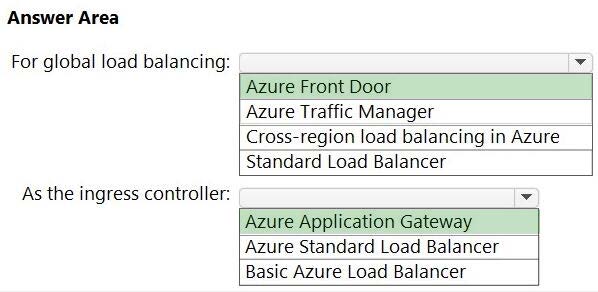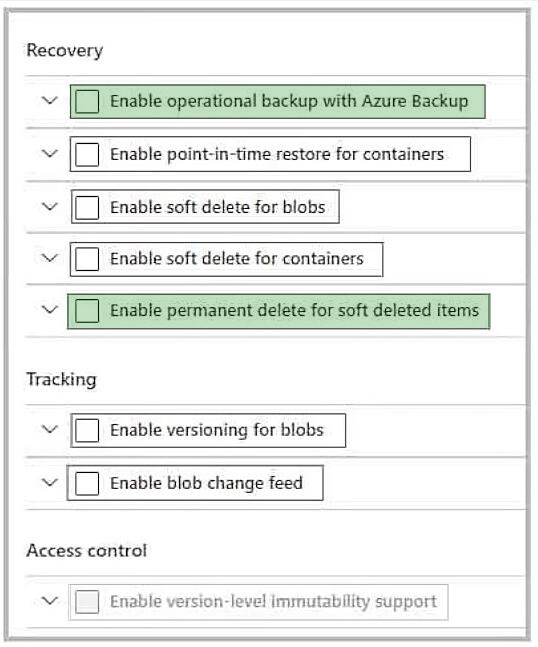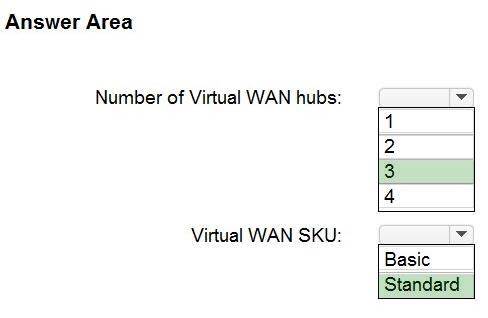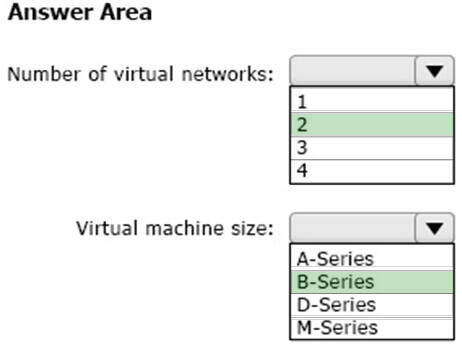Exam Details
Exam Code
:AZ-305Exam Name
:Designing Microsoft Azure Infrastructure SolutionsCertification
:Microsoft CertificationsVendor
:MicrosoftTotal Questions
:378 Q&AsLast Updated
:Mar 25, 2025
Microsoft Microsoft Certifications AZ-305 Questions & Answers
-
Question 291:
You plan to migrate App1 to Azure. The solution must meet the authentication and authorization requirements. Which type of endpoint should App1 use to obtain an access token?
A. Azure Instance Metadata Service (IMDS)
B. Azure AD
C. Azure Service Management
D. Microsoft identity platform
-
Question 292:
You migrate App1 to Azure.
You need to ensure that the data storage for App1 meets the security and compliance requirements.
What should you do?
A. Create Azure RBAC assignments.
B. Create an access policy for the blob service.
C. Modify the access level of the blob service.
D. Implement Azure resource locks.
-
Question 293:
HOTSPOT
You have the Azure subscriptions shown in the following table.

Contoso.onmicrosft.com contains a user named User1.
You need to deploy a solution to protect against ransomware attacks. The solution must meet the following requirements:
1.
Ensure that all the resources in Sub1 are backed up by using Azure Backup.
2.
Require that User1 first be assigned a role for Sub2 before the user can make major changes to the backup configuration.
What should you create in each subscription? To answer, select the appropriate options in the answer area.
NOTE: Each correct selection is worth one point.
Hot Area:

-
Question 294:
HOTSPOT
You have 10 on-premises servers that run Windows Server.
You need to perform daily backups of the servers to a Recovery Services vault. The solution must meet the following requirements:
1.
Back up all the files and folders on the servers.
2.
Maintain three copies of the backups in Azure.
3.
Minimize costs.
What should you configure? To answer, select the appropriate options in the answer area.
NOTE: Each correct selection is worth one point.
Hot Area:
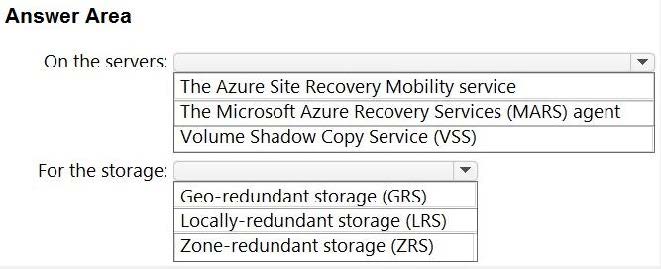
-
Question 295:
HOTSPOT
You plan to deploy a containerized web-app that will be hosted in five Azure Kubernetes Service (AKS) clusters. Each cluster will be hosted in a different Azure region.
You need to provide access to the app from the internet. The solution must meet the following requirements:
1.
Incoming HTTPS requests must be routed to the cluster that has the lowest network latency.
2.
HTTPS traffic to individual pods must be routed via an ingress controller.
3.
In the event of an AKS cluster outage, failover time must be minimized.
What should you include in the solution? To answer, select the appropriate options in the answer area.
NOTE: Each correct selection is worth one point.
Hot Area:
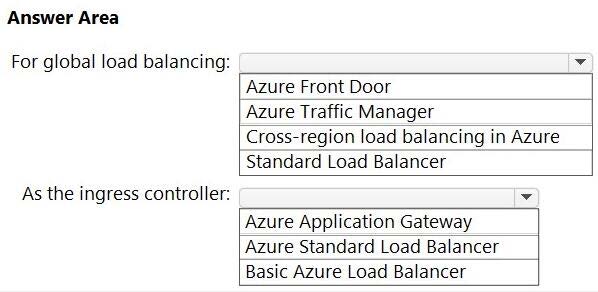
-
Question 296:
HOTSPOT
You have an Azure subscription.
You create a storage account that will store documents.
You need to configure the storage account to meet the following requirements:
1.
Ensure that retention policies are standardized across the subscription.
2.
Ensure that data can be purged if the data is copied to an unauthorized location.
Which two settings should you enable? To answer, select the appropriate settings in the answer area.
NOTE: Each correct selection is worth one point.
Hot Area:
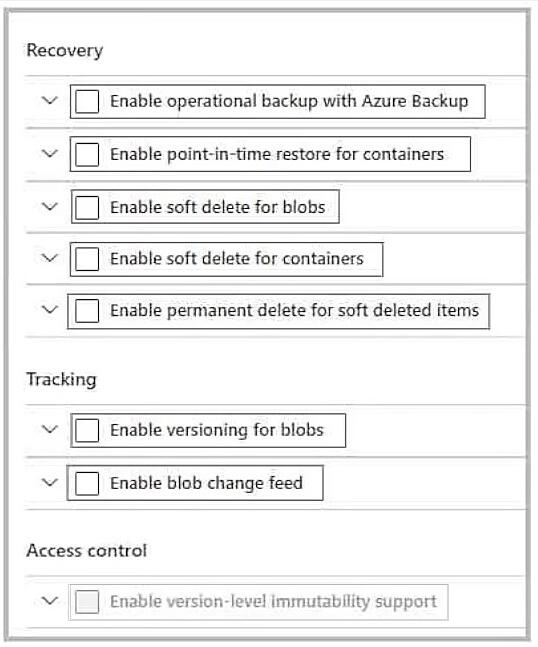
-
Question 297:
HOTSPOT
You have two Azure AD tenants named contoso.com and fabrikam.com. Each tenant is linked to 50 Azure subscriptions. Contoso.com contains two users named User1 and User2.
You need to meet the following requirements:
Ensure that User1 can change the Azure AD tenant linked to specific Azure subscriptions.
If an azure subscription is liked to a new Azure AD tenant, and no available Azure AD accounts have full subscription-level permissions to the subscription, elevate the access of User2 to the subscription.
The solution must use the principle of least privilege.
Which role should you assign to each user? To answer, select the appropriate options in the answer area.
NOTE: Each correct selection is worth one point.
Hot Area:
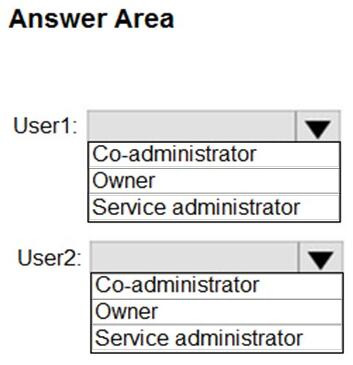
-
Question 298:
HOTSPOT
You company has offices in New York City, Sydney, Paris, and Johannesburg.
The company has an Azure subscription.
You plan to deploy a new Azure networking solution that meets the following requirements:
1.
Connects to ExpressRoute circuits in the Azure regions of East US, Southeast Asia, North Europe, and South Africa
2.
Minimizes latency by supporting connection in three regions
3.
Supports Site-to-site VPN connections
4.
Minimizes costs
You need to identify the minimum number of Azure Virtual WAN hubs that you must deploy, and which virtual WAN SKU to use.
What should you identify? To answer, select the appropriate options in the answer area.
NOTE: Each correct selection is worth one point.
Hot Area:

-
Question 299:
HOTSPOT
You are developing a multi-tier app named App1 that will be hosted on Azure virtual machines. The peak utilization periods for App1 will be from 8 AM to 9 AM and 4 PM to 5 PM on weekdays.
You need to deploy the infrastructure for App1. The solution must meet the following requirements:
1.
Support virtual machines deployed to four availability zones across two Azure regions.
2.
Minimize costs by accumulating CPU credits during periods of low utilization.
What is the minimum number of virtual networks you should deploy, and which virtual machine size should you use? To answer, select the appropriate options in the answer area.
Hot Area:
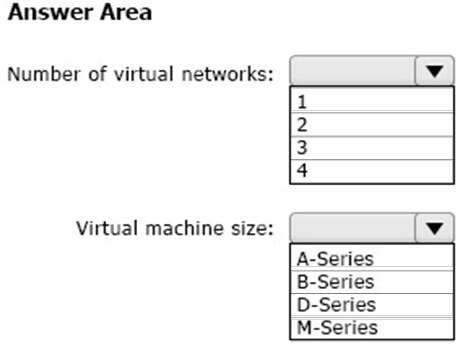
-
Question 300:
HOTSPOT
You have an Azure App Service web app named Webapp1 that connects to an Azure SQL database named DB1. Webapp1 and DB1 are deployed to the East US Azure region.
You need to ensure that all the traffic between Webapp1 and DB1 is sent via a private connection.
What should you do? To answer, select the appropriate options in the answer area.
NOTE: Each correct selection is worth one point.
Hot Area:

Related Exams:
62-193
Technology Literacy for Educators70-243
Administering and Deploying System Center 2012 Configuration Manager70-355
Universal Windows Platform – App Data, Services, and Coding Patterns77-420
Excel 201377-427
Excel 2013 Expert Part One77-725
Word 2016 Core Document Creation, Collaboration and Communication77-726
Word 2016 Expert Creating Documents for Effective Communication77-727
Excel 2016 Core Data Analysis, Manipulation, and Presentation77-728
Excel 2016 Expert: Interpreting Data for Insights77-731
Outlook 2016 Core Communication, Collaboration and Email Skills
Tips on How to Prepare for the Exams
Nowadays, the certification exams become more and more important and required by more and more enterprises when applying for a job. But how to prepare for the exam effectively? How to prepare for the exam in a short time with less efforts? How to get a ideal result and how to find the most reliable resources? Here on Vcedump.com, you will find all the answers. Vcedump.com provide not only Microsoft exam questions, answers and explanations but also complete assistance on your exam preparation and certification application. If you are confused on your AZ-305 exam preparations and Microsoft certification application, do not hesitate to visit our Vcedump.com to find your solutions here.


